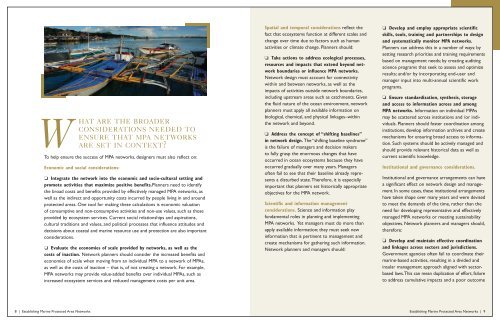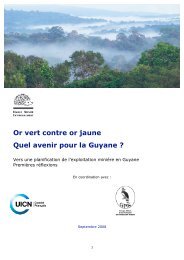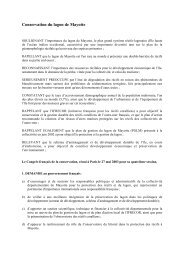Establishing Marine Protected Area Networks - Georgia Strait Alliance
Establishing Marine Protected Area Networks - Georgia Strait Alliance
Establishing Marine Protected Area Networks - Georgia Strait Alliance
You also want an ePaper? Increase the reach of your titles
YUMPU automatically turns print PDFs into web optimized ePapers that Google loves.
W<br />
HAT<br />
ARE THE BROADER<br />
CONSIDERATIONS NEEDED TO<br />
ENSURE THAT MPA NETWORKS<br />
ARE SET IN CONTEXT?<br />
To help ensure the success of MPA networks, designers must also reflect on:<br />
Economic and social considerations:<br />
❏ Integrate the network into the economic and socio-cultural setting and<br />
promote activities that maximize positive benefits.Planners need to identify<br />
the broad costs and benefits provided by effectively managed MPA networks, as<br />
well as the indirect and opportunity costs incurred by people living in and around<br />
protected areas. One tool for making these calculations is economic valuation<br />
of consumptive and non-consumptive activities and non-use values, such as those<br />
provided by ecosystem services. Current social relationships and aspirations,<br />
cultural traditions and values, and political processes that influence attitudes and<br />
decisions about coastal and marine resource use and protection are also important<br />
considerations.<br />
❏ Evaluate the economies of scale provided by networks, as well as the<br />
costs of inaction. Network planners should consider the increased benefits and<br />
economies of scale when moving from an individual MPA to a network of MPAs,<br />
as well as the costs of inaction – that is, of not creating a network. For example,<br />
MPA networks may provide value-added benefits over individual MPAs, such as<br />
increased ecosystem services and reduced management costs per unit area.<br />
Spatial and temporal considerations reflect the<br />
fact that ecosystems function at different scales and<br />
change over time due to factors such as human<br />
activities or climate change. Planners should:<br />
❏ Take actions to address ecological processes,<br />
resources and impacts that extend beyond network<br />
boundaries or influence MPA networks.<br />
Network design must account for connectivity<br />
within and between networks, as well as the<br />
impacts of activities outside network boundaries,<br />
including upstream areas such as catchments. Given<br />
the fluid nature of the ocean environment, network<br />
planners must apply all available information on<br />
biological, chemical, and physical linkages–within<br />
the network and beyond.<br />
❏ Address the concept of “shifting baselines”<br />
in network design. The “shifting baseline syndrome”<br />
is the failure of managers and decision makers<br />
to fully grasp the enormous changes that have<br />
occurred in ocean ecosystems because they have<br />
occurred gradually over many years. Managers<br />
often fail to see that their baseline already represents<br />
a disturbed state.Therefore, it is especially<br />
important that planners set historically appropriate<br />
objectives for the MPA network.<br />
Scientific and information management<br />
considerations. Science and information play<br />
fundamental roles in planning and implementing<br />
MPA networks. Yet managers must do more than<br />
apply available information; they must seek new<br />
information that is pertinent to management and<br />
create mechanisms for gathering such information.<br />
Network planners and managers should:<br />
❏ Develop and employ appropriate scientific<br />
skills, tools, training and partnerships to design<br />
and systematically monitor MPA networks.<br />
Planners can address this in a number of ways: by<br />
setting research priorities and training requirements<br />
based on management needs; by creating auditing<br />
science programs that seek to assess and optimize<br />
results; and/or by incorporating end-user and<br />
manager input into multi-annual scientific work<br />
programs.<br />
❏ Ensure standardization, synthesis, storage<br />
and access to information across and among<br />
MPA networks. Information on individual MPAs<br />
may be scattered across institutions and /or individuals.<br />
Planners should foster coordination among<br />
institutions, develop information archives and create<br />
mechanisms for ensuring broad access to information.<br />
Such systems should be actively managed and<br />
should provide relevant historical data as well as<br />
current scientific knowledge.<br />
Institutional and governance considerations.<br />
Institutional and governance arrangements can have<br />
a significant effect on network design and management.<br />
In some cases, these institutional arrangements<br />
have taken shape over many years and were devised<br />
to meet the demands of the time, rather than the<br />
need for developing representative and effectively<br />
managed MPA networks or meeting sustainability<br />
objectives. Network planners and managers should,<br />
therefore:<br />
❏ Develop and maintain effective coordination<br />
and linkages across sectors and jurisdictions.<br />
Government agencies often fail to coordinate their<br />
marine-based activities, resulting in a divided and<br />
insular management approach aligned with sectorbased<br />
laws.This can mean duplication of effort, failure<br />
to address cumulative impacts and a poor outcome<br />
8 | <strong>Establishing</strong> <strong>Marine</strong> <strong>Protected</strong> <strong>Area</strong> <strong>Networks</strong> <strong>Establishing</strong> <strong>Marine</strong> <strong>Protected</strong> <strong>Area</strong> <strong>Networks</strong> | 9
















